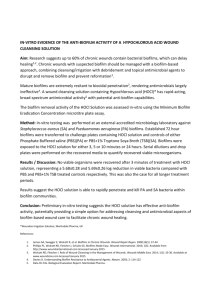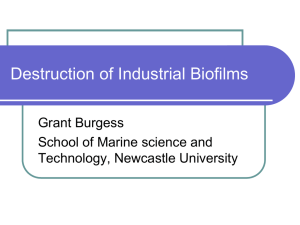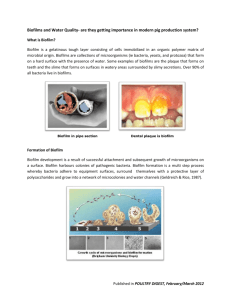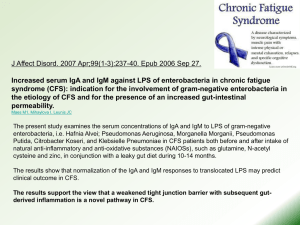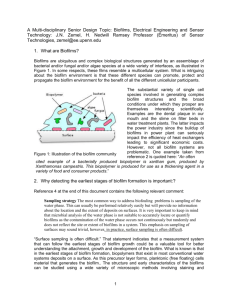Review - Wound Infection Institute
advertisement
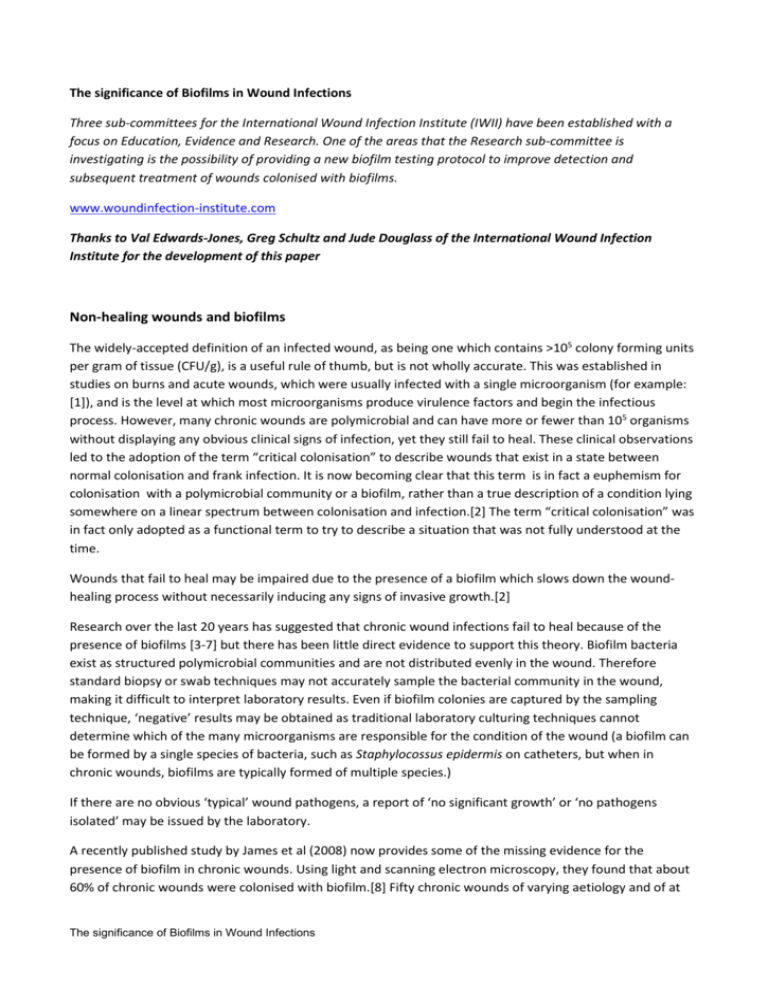
The significance of Biofilms in Wound Infections Three sub-committees for the International Wound Infection Institute (IWII) have been established with a focus on Education, Evidence and Research. One of the areas that the Research sub-committee is investigating is the possibility of providing a new biofilm testing protocol to improve detection and subsequent treatment of wounds colonised with biofilms. www.woundinfection-institute.com Thanks to Val Edwards-Jones, Greg Schultz and Jude Douglass of the International Wound Infection Institute for the development of this paper Non-healing wounds and biofilms The widely-accepted definition of an infected wound, as being one which contains >105 colony forming units per gram of tissue (CFU/g), is a useful rule of thumb, but is not wholly accurate. This was established in studies on burns and acute wounds, which were usually infected with a single microorganism (for example: [1]), and is the level at which most microorganisms produce virulence factors and begin the infectious process. However, many chronic wounds are polymicrobial and can have more or fewer than 105 organisms without displaying any obvious clinical signs of infection, yet they still fail to heal. These clinical observations led to the adoption of the term “critical colonisation” to describe wounds that exist in a state between normal colonisation and frank infection. It is now becoming clear that this term is in fact a euphemism for colonisation with a polymicrobial community or a biofilm, rather than a true description of a condition lying somewhere on a linear spectrum between colonisation and infection.[2] The term “critical colonisation” was in fact only adopted as a functional term to try to describe a situation that was not fully understood at the time. Wounds that fail to heal may be impaired due to the presence of a biofilm which slows down the woundhealing process without necessarily inducing any signs of invasive growth.[2] Research over the last 20 years has suggested that chronic wound infections fail to heal because of the presence of biofilms [3-7] but there has been little direct evidence to support this theory. Biofilm bacteria exist as structured polymicrobial communities and are not distributed evenly in the wound. Therefore standard biopsy or swab techniques may not accurately sample the bacterial community in the wound, making it difficult to interpret laboratory results. Even if biofilm colonies are captured by the sampling technique, ‘negative’ results may be obtained as traditional laboratory culturing techniques cannot determine which of the many microorganisms are responsible for the condition of the wound (a biofilm can be formed by a single species of bacteria, such as Staphylocossus epidermis on catheters, but when in chronic wounds, biofilms are typically formed of multiple species.) If there are no obvious ‘typical’ wound pathogens, a report of ‘no significant growth’ or ‘no pathogens isolated’ may be issued by the laboratory. A recently published study by James et al (2008) now provides some of the missing evidence for the presence of biofilm in chronic wounds. Using light and scanning electron microscopy, they found that about 60% of chronic wounds were colonised with biofilm.[8] Fifty chronic wounds of varying aetiology and of at The significance of Biofilms in Wound Infections least 30 days’ duration, and 16 acute wounds were investigated by microscopy, while 27 chronic wounds were also subject to population analysis using molecular techniques. Microscopic analysis revealed the presence of densely aggregated colonies of bacteria, often surrounded by extracellular matrix. This was observed in only one acute wound while 30 of the chronic wounds had clear biofilm formation (p<0.001). Population studies using molecular techniques revealed diverse polymicrobial communities and in some specimens, strict anaerobes that were not revealed by standard culture techniques. Of course, an alternative interpretation of the results is that the material observed in microscopy may not have been a true biofilm but may simply be slough. However, it is worth asking what is the nature of “slough”? It consists predominantly of fibrin and necrotic tissue within which is embedded numerous bacteria. This accumulates on the surface of the chronic wound and is rarely seen in an acute wound. If the biofilm were not present it is likely there would also not be slough. Further evidence for the presence of biofilm comes from Bjarnsholt et al (2008) who analysed sections from chronic wounds using fluorescent in situ hybridisation (FISH), and found distinct microcolonies, the basic structures of biofilms.[2] The development of biofilms Bacterial biofilms are structured communities of bacterial cells enclosed in a self-produced polymeric matrix adhering to inert or living surfaces.[9] The cells attached to the surface are called ‘sessile’ and those free living at the surface of the biofilms are called planktonic bacteria. Biofilms in natural environments are resistant to bacteriophages (bacterial viruses), amoebae and to the powerful chemical biocides used in the industrial environment. In man, sessile bacterial cells can resist innate and acquired host immune responses and are up to 1000 times more resistant to antibiotics than planktonic cells. Whether this is due to a property of the sessile cells or to a protective effect from the other bacteria in the community is dependent upon the nature of the biofilm. It is important to understand the mechanisms by which biofilms form as these may provide opportunities for the development of medication that could prevent or disrupt their formation. It is generally accepted that there are a number of phases in the development of a biofilm: initial attachment and formation of microcolonies; maturation of attached bacteria into a differentiated biofilm; and dispersal of planktonic bacteria from mature biofilm. Attachment and formation of microcolonies. When a bacterium encounters a suitable surface it explores the surface in a process called “twitching”.[10, 11] Specific cell surface components are required for adhesion to a surface and the very process of attachment initiates synthesis of extracellular matrix.[12] This was also demonstrated by Davies et al (1995) who showed that, within minutes of attachment of P aeruginosa to a solid surface, genes that synthesise extracellular polysaccharide (alginate) were upregulated.[13] During the first hour of attachment, over 800 new proteins can be expressed,[14] radically changing the phenotype of the bacterium.[15] The attached cells continue to grow and divide while recruiting additional planktonic cells to the colony. At a certain stage of the biofilm formation, the microcolonies differentiate into mature biofilms with water-filled channels through which nutrients can flow in and waste products can be removed. This is an essential stage for the survival of the biofilm which continues to mature. The significance of Biofilms in Wound Infections Maturation and differentiation. Research on the behaviour of bacteria when in groups, has shown that individual bacterial cells communicate via cell-to-cell signalling systems. In Gram-negative bacteria, specific genes direct the production of extracellular acylhomoserine lactone molecules (acyl-HLSs), that function in a similar way to hormones, diffusing out of the cell and into other bacterial cells. The acyl-HLSs accumulate in proportion to the total number of cells present and therefore provide an index of the density of the population, in effect, a quorum sensor. Gram-positive bacteria use small peptides, around 5 to 17 amino acids in length, as signalling molecules.[16] When these “quorum sensing” signals accumulate to a certain critical level, genes are activated that trigger differentiation of the biofilm into loosely-packed pillar and mushroom like colonies, with the bacterial cells embedded in thick polymeric walls resistant to biocides.[17] The polymeric wall may contain polysaccharides, alginate, extracellular DNA and components such as proteins and lipids.[2] Living, fully hydrated biofilms are composed of around 15% by volume of cells and 85% of matrix material.[3] Rhoads suggests that the cells at the base of the biofilm are “rooted” to the surface, and that the biofilm will continue to regenerate so long as the root is still attached to the source of nutrients.[18] Modern methods (FISH) have demonstrated the architecture and special organisation of the relative species in a multi-soecies biofilm. In addition, expression studies have shown that there is a variation of activity between sessile and planktonic forms of the same species [19,20] Seeding of planktonic bacteria. A mechanism of dispersion is required if bacteria within a biofilm are to colonise new areas. Pieces of biofilm may be physically detached and carried to new surfaces and it has also been suggested that sessile bacteria may produce an enzyme that digests the alginate matrix allowing dispersion of individual bacteria.[21] The impact of biofilms on wounds Biofilm formation confers great advantage to the bacteria: the exopolysaccharide shield provides a physical barrier; bacteria within the biofilm can reduce their metabolic activity and thereby increase their tolerance to antibiotics; and sub-communities of facultative anaerobes or strict anaerobes can develop within niches of the biofilm community where nutrients and oxygen may be limited. It has also been suggested that biofilms modulate their virulence in order to remain attached to their source of nutrients.[22, 23] Because of this, biofilms often remain in stasis and infections can be slow to produce overt symptoms, if at all. Biofilms do release antigens that stimulate the production of antibodies, but these are incapable of killing the protected sessile bacteria and instead cause damage to surrounding tissues.[2] Antibiotics can resolve the symptoms caused by planktonic cells but have little or no effect on the biofilm itself.[2, 24] Bacteria in biofilms are protected from systemic and topical agents, from endogenous antibodies and phagocytic cells[25, 26], and thus are relatively free to cause extensive tissue damage and delay healing. Biofilms are highly inflammatory, constantly shedding bacteria onto the surface of the wound, exciting an immunological response which causes tissue damage and maintains chronic inflammation. Biofilms therefore appear to “recur” despite repeated attempts at antibiotic therapy. As a result of wound biofilms, keratinocytes are unable to migrate across the wound bed, there is low oxygen at the wound surface, and host defences are unable to penetrate or remove the biofilm. Bjarnsholt et al (2008) suggest that this is due to the fact that biofilms disable host defences. In studies on biofilm microcolonies of P aeruginosa the quorum sensing communication system was shown to regulate The significance of Biofilms in Wound Infections production of a rhamnolipid that can eliminate polymorphonuclear leukocytes (PMNs).[27, 28] This effectively builds a “PMN shield” around the colony that suppresses the cellular defence system. Killing and lysis of PMNs result in the release of large quantities of cytotoxic enzymes, free oxygen radicals and inflammatory mediators that damage host tissue and maintain the chronicity of the wound, without affecting the biofilm. Treatment of biofilms Effect of antibiotics on biofilms Microorganisms in a biofilm have an inherent lack of susceptibility to antibiotics, compared to planktonic cultures of the same organism.[29] In 1999, Ceri formed biofilms from NCCLS reference strains of E coli, P aeruginosa and S aureus and tested the minimal inhibitory concentration (MIC) of a range of antibiotics indicated for each type of bacteria.[30] While the MIC values for the planktonic form of each strain were as expected, the minimal biofilm eradication concentrations (MBECs) were generally 100 to 1000 times higher. Hoyle et al (1992) found that planktonic bacterial cells were 15 times more susceptible to tobramycin than cells in intact biofilms.[31] These findings have been confirmed by many other studies; some MBECs have even been found to exceed the maximum allowable prescription level.[27, 30-33] Mathematical modelling of the processes of diffusion suggests that exopolysaccharide matrices can be highly effective barriers if the antimicrobial agent can be deactivated faster than it can diffuse through the matrix. The negatively charged polymeric substances that make up the walls of a biofilm are known to retard the diffusion of antibiotics. Suci et al (1994) showed that there was delayed penetration of ciprofloxacin into P aeruginosa biofilms: the normal penetration time of 40 seconds was increased to 21 minutes on a biofilmcontaining surface.[36] A 2% suspension of alginate isolated from P aeruginosa was able to inhibit diffusion of gentamicin and tobramycin,[33] and Allison and Matthews (1992) observed reduced diffusion and antimicrobial activity of tobramycin and to a lesser extent of ciprofloxacin through P aeruginosa biofilm.[38] Using four different antibiotic groups, Koseoglu et al (2006) found that development of E coli biofilms on urethral catheters could only be delayed, not prevented.[35] The polymeric barrier is also effective against reactive species, such as hypochlorite and hydrogen peroxide which are produced by phagocytic cells. Alginate is a scavenger of free oxygen radicals, prevents phagocytosis, and can bind cationic antibiotics such as the aminoglycosides.[36, 37,38, 39] It has also been shown that biofilm bacteria, like planktonic bacteria, contain efflux pumps that are able to pump out antimicrobial agents. However, using strains of P aeruginosa with either defective, or overproductive, efflux pumps, Brooun et al (2000) were not able to detect any pumping mechanism and suggested that this resistance mechanism may be masked by other mechanisms that are also operating in the biofilm.[25] Another possibility is that at least some of the cells in a biofilm exist in a slow-growing or semi-starved state.[29] Evans et al (1990) found that the slowest growing E coli cells in biofilms were the most resistant to cetrimide.[40] As many antibiotics work by targeting the metabolic processes of bacteria, cells in a state of reduced metabolism will not be highly susceptible to antimicrobial agents, and a proportion will therefore always be more likely to survive an attack. The significance of Biofilms in Wound Infections A third proposed mechanism is that some of the bacteria in a biofilm develop into a distinct phenotype which is inherently more resistant to traditional antibiotics. Dagostino et al (1991) suggested that the initial adhesion to a surface might result in certain genetic changes which could affect the physiological responses of the bacteria.[41] The fact that free-floating planktonic bacteria can be susceptible to standard doses of antibiotics can cause confusion and difficulty in managing wounds that are colonised with biofilms. Planktonic bacteria are shed from the biofilm and can be eliminated with antibiotics, thereby providing symptomatic relief. However, because the biofilm is not eliminated, once the antibiotic is stopped, it appears to the clinician that reinfection has occurred. Antimicrobials and biofilms Percival et al (2008) demonstrated that a silver hydrogel dressing (ionic silver) was able to kill 90% of all sessile bacteria within three common biofilms in 24 hours, and total bacterial kill was achieved within 48 hours. The biofilms studied were P aeruginosa, Enterobacter cloacae, S aureus and mixed communities of more than one type of bacterium.[42] In an earlier paper, the authors demonstrated that sessile bacteria were far less susceptible than planktonic bacteria to silver dressings.[43] Using an in vitro model they found that a silver-containing hydrofibre dressing was more effective against strains of P aeruginosa, Candida albicans and S aureus; while a nanocrystalline silver dressing was more effective against strains of Klebsiella pneumoniae, Enterococcus faecalis and E coli. However, these biofilms were immature, only 24 hours old, and further research has shown that silver hydrogel dressings are less effective on three-day old, mature biofilms.(unpublished thesis, Q Yang, Institute for Wound Research, University of Florida) This and other research demonstrates that immature biofilms behave differently to mature biofilms in terms of susceptibility to antimicrobial agents and dressings. However, it does appear that mature biofilms can be fully killed by iodine releasing dressings.(as above, Q Yang) Akiyama et al (2006) were able to clear S aureus biofilm in vitro and in vivo using a mouse model.[44] They suggest that the cadexomer iodine beads adsorb biofilm-protected S aureus cells and that the protective glycocalyx collapses during dehydration. This is followed by liberation of iodine which is capable of directly killing the biofilm S aureus cells. New approaches Clearly, there are many points in the process of biofilm development which are potential therapeutic targets: disruption of the cell surface components that are required for adhesion; disruption of the quorum sensing process; and stimulation of the enzymes that digest alginate. A number of agents have been developed in industrial and dental sectors to counter biofilm development. In the food industry, bovine lactoferrin is used as an anti-biofilm agent against P aeruginosa. This substance prevents the bacteria from attaching to the target surface, rendering them unable to produce biofilm structures. [10, 45] A number of studies have proven the validity of the concept of quorum-sensing inhibitors (QSIs) as antimicrobial treatment. Differentiation and maturation of the biofilm can be disrupted if the cell-to-cell signalling process is blocked.[25] In P aeruginosa biofilms it has been shown that a synthetic halogenated furanone compound is capable of interfering with acyl-HLS signalling.[46] The compound can penetrate The significance of Biofilms in Wound Infections microcolonies and block cell signalling and quorum sensing. It does not affect initial attachment to the substrate but it does affect the architecture of the biofilm, enhancing the process of detachment. Application of the drug to P aeruginosa biofilms in mice inhibited quorum sensing of bacteria and promoted their clearance by the immune response of the mouse.[47] Other quorum sensing inhibitors have been identified such as RNA III inhibitory peptide which inhibits the agr system of Gram-positive bacteria.[48-52] Debridement of biofilms Until some of these newer methods reach the stage of commercialisation, the only sure method of treating biofilm is physical removal through thorough debridement, followed by the application of effective antimicrobials, antibiotics or antiseptics to prevent re-formation. Disrupting the community through debridement will not directly kill the bacteria, but the disturbance does allow other concomitant therapies and natural host defences to work more effectively.[53] The aim of a debride-and-cover strategy is therefore to remove the nidus of infection that perpetuates a state of chronic inflammation and to give the host defences the best possible change to recover.[54] If infection is spreading, then rapid methods of debridement, either surgical or sharp, are to be preferred.[53] Patients who are unable to undergo surgical debridement may be treated with alternatives such as absorbent dressings, negative pressure therapy or possibly hydrosurgical debridement. Following debridement, the wound must be covered to limit further colonisation and cross-contamination. Topical antibiotics should be avoided in the management of infected wounds: their effectiveness against biofilms is limited and over-use may result in the emergence of resistance.[52] Silver- and iodine-containing dressings may have limited effectiveness in killing established biofilm, but are able to delay, or even prevent, the formation of new biofilm following debridement and have some efficacy against newly established bioflms. There is a growing body of evidence to support the use of silver and iodine dressings in infected wounds.[55, 56] In clinical terms it is important to reject the notion that “critical colonisation” is something benign that is below the level of infection, and that does not require active intervention. Biofilms need to be reduced or eliminated for the wound to heal. Until pharmacological agents are available that can reliably and consistently eliminate biofilm, the role of debridement is crucial. Detailed information on how to deal with infected or colonised wounds can be found in the consensus document on wound infection published in 2008 by the International Wound Infection Institute.[54] Methods in development for culturing biofilm bacteria Clinicians need to know that biofilms are present in order to begin appropriate treatment. Currently, many clinicians observe the consequences of biofilm in wounds rather than the actual biofilm. Biofilm microcolonies can not be seen by eye, until they have grown to an enormous size, such as those seen in dental plaque. Swabbing results may be misleading as clinical microbiology laboratories use methods that select for planktonic bacteria, are not always suitable for culture of anaerobic species, and the sampling technique The significance of Biofilms in Wound Infections may not capture bacteria protected within a biofilm, thus resulting in a negative or inconclusive culture report.[55] Methods are currently in development that aim to make the detection of biofilm bacteria more routine. The International Wound Infection Institute is providing support to a research project to confirm and validate techniques that can be made available to all clinicians engaged in the fight against wound infection. Conclusion The presence of biofilms in chronic wounds eluded clinicians for many years, largely due to the difficulty in isolating biofilms with standard sampling and culturing methods. Application of scanning and light microscopy techniques have now revealed the ubiquitous nature of biofilms, particularly in chronic wounds. Biofilms have evolved specific survival strategies that make them highly resistant to most forms of antibiotic. While new pharmacological agents are being developed to disrupt biofilm formation, the most effective method of eliminating biofilms is physical removal, through debridement. To enable clinicians to rapidly confirm the presence and nature of biofilm in chronic wounds, the authors propose a modified culturing method which is currently under development. Key points The term “critical colonisation” should be rejected. Wounds that fail to heal are probably colonised with biofilm. About 60% of chronic wounds are colonised with biofilm but standard biopsy or swab techniques may not accurately sample biofilm. Biofilms are highly inflammatory, shed bacteria into the wound, exciting an immunological response, tissue damage and chronic inflammation. Planktonic bacteria can be eliminated with antibiotics, providing symptomatic relief. Biofilms form through: initial attachment and formation of microcolonies; maturation of attached bacteria into differentiated biofilm; dispersal of planktonic bacteria. Individual biofilm bacterial cells communicate via cell-to-cell signalling systems: “quorum sensing”. Biofilm shields provide a physical barrier; bacteria within the biofilm can reduce their metabolic activity; and sub-communities of facultative anaerobes or strict anaerobes can develop within biofilms. Bacteria in biofilms are protected from systemic and topical agents, from endogenous antibodies and phagocytic cells. Biofilms need to be reduced or eliminated for the wound to heal. Potential therapeutic targets are: disruption of the cell surface components required for adhesion; disruption of the quorum sensing process; and stimulation of the enzymes that digest alginate. The significance of Biofilms in Wound Infections Currently, the only sure method of treating biofilm is physical removal through thorough debridement, followed by the application of effective antimicrobials, antibiotics or antiseptics to prevent re-formation: debride-and-cover strategy. There is a growing body of evidence to support the use of silver and iodine dressings in infected wounds. Methods to improve detection of biofilm are currently in development. The significance of Biofilms in Wound Infections Key papers 1. 2. 3. 4. 5. 6. 7. 8. 9. 10. 11. 12. 13. 14. 15. 16. 17. 18. 19. 20. 21. 22. 23. Robson MC, Lea CE, Dalton JB, Heggers JP. Quantitative bacteriology and delayed wound closure. Surg Forum 1968; 19: 501-2 Bjarnsholt T, Kirketerp-Moller K, Jensen PO, Madsen KG, Phipps R, Krogfelt K, Holby N, Givskov M. Why chronic wounds will not heal: a novel hypothesis. Wound Repair Regen 2008; 16: 2-10 Donlan RM, Costerton JW. Biofilms: survival mechanisms of clinically relevant microorganisms. Clin Microbiol Rev 2002; 15: 167-93 Parsek MR, Singh PK. Bacterial biofilms: an emerging link to disease pathogenesis. Ann Rev Microbiol 2003; 57: 677-701 Serralta VW, Harrison-Balestra C, Cazzaniga AL, Davis SC, Mertz PM. Lifestyles of bacteria in wounds: presence of biofilms? Wounds 2001; 13: 29-34 Mertz PM. Cutaneous biofilms: friend or foe? Wounds 2003; 15: 129-32 Davis SC, Ricotti C, Cazzaniga A, Welsh E, Eaglstein WH, Mertz PM. Microscopic and physiologic evidence for biofilm-associated wound colonization in vivo. Wound Repair Regen 2008; 16: 23-9 James GA, Swogger E, Wolcott R, Pulcini Ed, Secor P, Sestrich J, Costerton JW, Stewart PS. Biofilms in chronic wounds. Wound Repair Regen 2008; 16: 37-44 Costerton JW, Stewart PS, Greenberg EP. Bacterial biofilms: a common cause of persistent infections. Science 1999; 284: 1318-22 Singh PK, Parsek MR, Greenberg EP, Welsh MJ. A component of innate immunity prevents bacterial biofilm development. Nature 2002; 417: 552-5 Meier-Davis S. Host response to biofilms, foreign implants and devices., in Biofilms, infection and antimicrobial therapy., Pace JL, Rupp ME, and Roger GF, Editors. 2006, ????: ??? p. 315-7 Boyd A, Chakrabarty AM. Pseudomonas aeruginosa biofilms: role of the alginate exopolysaccharide. J Ind Microbiol 1995; 15: 162-8 Davies DG, Geesey GG. Regulation of the alginate biosynthesis gene algC in Pseudomonas aeruginosa during biofilm development in continuous culture. Appl Environ Microbiol 1995; 61: 8607 Sauer K, Camper AK. Characterization of phenotypic changes in Pseudomonas putida in response to surface-associated growth. J Bacteriol 2001; 183: 6579 Stoodley P, Sauer K, Davies DG, Costerton JW. Biofilms as complex differentiated communities. Ann Rev Microbiol 2002; 56: 187-209 Lazazzera BA, Grossman AD. The ins and outs of peptide signaling. Trends Microbiol 1998; 6: 288-94 Davies DG, Parsek MR, Pearson JP, Iglewski BH, Costerton JW, Greenberg EP. The involvement of cell-to-cell signals in the development of a bacterial biofilm. Science 1998; 280: 295-8 Rhoads DD, Wolcott RW, Cutting KF, Percival SL. Evidence of biofilms in wounds and the potential ramifications., in Biofims: coming of age., Gilbert P, et al., Editors. 2007, The Biofilm Club: Manchester Thurnheer T, Gmür R, Guggenheim B. Multiple FISH analysis of a six-species bacterial biofilm. J Microbiol Methods 2004;56(1):37-47 Lo, AW, Seers CA, Boyce JD, Dashper SG, Slakeski N, Lissel JP, Reynolds EC. Comparative transcriptomic analysis of Porphyromonas gingivalis biofilm and planktonic cells. BMC Microbiol. 2009;29;9:18 Boyd A, Chakrabarty AM. Role of alginate lyase in cell detachment of Pseudomonas aeruginosa. Appl Environ Microbiol 1994; 60: 2355-9 Torres VJ, Stauff DL, Ishchany G, Ezbradica JS, Ordy LE, Turregui J, Anderson KL, Dunman P, Joyce S, Skaar EP. A staphylococcus aureus regulatory system that responds to host heme and modulates virulence. Cell Host and Microbe. 2007; 1: 109-19 Reniere ML, Torres VJ, Skaar EP. Intracellular metalloporphyrin metabolism in Staphylococcus aureus. Biometals 2007; 20: 333-45 The significance of Biofilms in Wound Infections 24. 25. 26. 27. 28. 29. 30. 31. 32. 33. 34. 35. 36. 37. 38. 39. 40. 41. 42. 43. 44. 45. Marrie TJ, Nelligan J, Costerton JW. A scanning and transmission electron microscopic study of an infected endocardial pacemaker lead. Circulation 1982; 66: 1339-41 Brooun A, Liu SH, Lewis K. A dose-response study of antibiotic resistance in Pseudomonas aeruginosa biofilms. Antimicrob Agents Chemother 2000; 44: 640-6 Leid JG, Shirtliff ME, Costerton JW, Stoodley AP. Human leukocytes adhere to, penetrate, and respond to Staphylococcus aureus biofilms. Infect Immun 2002; 70: 6339-45 Bjarnsholt T, Jensen PO, Burmolle M, Hentzer M, Haagensen JA, Hougen HP, Calum H, Madsen KG, Moser C, Molin S, Hoiby N, Givskov M. Pseudomonas aeruginosa tolerance to tobramycin, hydrogen peroxide and polymorphonuclear leukocytes is quorum-sensing dependent. Microbiol 2005; 151: 373-83 Jensen PO, Bjarnsholt T, Rasmussen TB, Calum H, Moser C, Pressler T, Givskov M, Hoiby N. Rapid necrotic killing of PMNs is caused by quorum sensing controlled production of rhamnolipid by Pseudomonas aeruginosa. Microbiol 2006; 3: 225-31 Brown MRW, Allison DG, Gilbert P. Resistance of bacterial biofilms to antibiotics: a growth-rate related effect? J Antimicrob Chemother 1988; 22: 777-83 Ceri H, Olson ME, Stremick C, Read RR, Morck D, Buret A. The Calgary biofilm device: new technology for rapid determination of antibiotic susceptibilities of bacterial biofilms. J Clin Microbiol 1999; 37: 1771-76 Hoyle BD, Wong CK, Costerton JW. Disparate efficacy of tobramycin on Ca2+-, Mg2+- and HEPEStreated Pseudomonas aeruginosa biofilms. Can J Microbiol 1992; 38: 1214-8 Larsen T, Fiehn N-E. Resistance of Streptococcus sanguis biofilms to antimicrobial agents. APMIS 1996; 104: 280-4 Vorachit M, Lam K, Jayanetra P, Costerton JW. Resistance of Pseudomonsa pseudomallei growing as a biofilm on silastic disks to ceftazidime and cotrimoxazole. Antimicrob Agents Chemother 1993; 37: 2000-2 Olson ME, Ceri H, Morck DW, Buret AG, Read RR. Biofilm bacteria: formation and comparative susceptibility to antibiotics. Can J Vet Res 2002; 66: 86-92 Koseoglu H, Aslan G, Esen N, Sen BH, Coban H. Ultrastructural stages of biofilm development of Escherichia coli on urethral catheters and effects of antibiotics on biofilm formation. Urol 2006; 68: 942-6 Suci PA, Mittelman MW, Yu FP, Geesey GG. Investigation of ciprofloxacin penetration into Pseudomonas aeruginosa biofilms. Antimicrob Agents Chemother 1994; 38: 2125-33 Hatch RA, Schiller NL. Alginate lyase promotes diffusion of aminoglycosides through the extracellular polysaccharide of mucoid Pseudomonas aerguinosa. Antimicrob Agents Chemother 1998; 42: 974-7 Allison DG, Matthews MJ. Effect of polysaccharide interactions on antibiotic susceptibility of Pseudomonas aeruginosa. J Appl Bacteriol 1992; 73: 484-8 Simpson JA, Smith SE, Dean RT. Scavenging by alginate of free radicals released by macrophages. Free Radic Biol Med 1989; 6: 347-53 Evans DJ, Allison DG, Brown MRW, Gilbert P. Effect of growth-rate on resistance of gram-negative biofilms to cetrimide. J Antimicrob Chemother 1990; 26: 473-8 Dagostino L, Goodman AE, Marshall KC. Physiological responses induced in bacteria adhering to surfaces. Biofouling 1991; 4: 113-9 Percival SL, Bowler PG, Woods EJ. Assessing the effect of an antimicrobial wound dressing on biofilms. Wound Repair Regen 2008; 16: 52-57 Percival SL, Bowler PG, Dolman J. Antimicrobial activity of silver-containing dressings on wound microorganisms using an in vitro biofilm model. Int Wound J 2007; 4: 186-91 Akiyama H, Oono T, Saito M, Iwatsuki K. Assessment of cadexomer iodine against Staphylococcus aureus biofilm in vivo and in vitro using confocal laser scannin microscopy. J Dermatol 2004; 31: 52934 Singh PK. Iron sequestration by human lactoferrin stimulates P aeruginosa surface motility and blocks biofilm formation. Biometals 2004; 17: 267-70 The significance of Biofilms in Wound Infections 46. 47. 48. 49. 50. 51. 52. 53. 54. 55. 56. 57. Hentzer M, Riedel K, Rasmussen TB, Heydorn A, Andersen JB, Parsek MR, Rice SA, Eberl L, Molin S, Hoiby N, Kjelleberg S, Givskov M. Inhibition of quorum sensing in Pseudomonas aeruginosa biofilm bacteria by a halogenated furanone compound. Microbiol 2002; 148: 87-102 Hentzer M, Wu H, Andersen JB, Riedel K, Rasmussen TB, Bagge N, Kumar N, Schembri MA, Song Z, Kristoffersen P, Manefield M, Costerton JW, Molin S, Eberl L, Steinberg P, Kjelleberg S, Hoiby N, Givskov M. Attenuation of Pseudomonas aeruginosa virulence by quorum sensing inhibitors. EMBO J 2003; 22: 3803-15 Balaban N, Stoodley P, Fux CA, Wilson S, Costerton JW, Dell'Acqua G. Prevention of staphylococcal biofilm-associated infections by the quorum sensing inhibitor RIP. Clin Orthop Relat Res 2005; 437: 48-54 Cirioni O, Giacometti A, Ghiselli R, Dell'Acqua G, Orlando F, Mocchegiani F, Silvestri C, Licci A, Saba V, Scalise G, Balaban N. RNAIII-inhibiting peptide significantly reduces bacterial load and enhances the effect of antibiotics in the treatment of central venous catheter-associated Staphylococcus aureus infections. J Infect Dis 2006; 193: 180-6 Domenico P, Gurzenda E, Giacometti A, Cirioni O, Ghiselli R, Orlando F, Korem M, Saba V, Scalise G, Balaban N. BisEDT and RIP act in synergy to prevent graft infections by resistant Staphylococci. Peptides 2004; 12: 2047-53 Giacometti A, Cirioni O, Gov Y, Ghiselli R, Del Prete MS, Mocchegiani F, Saba V, Orlando F, Scalise G, Balaban N, Dell'Acqua G. RNA III inhibiting peptide inhibits in vivo biofilm formation by drug-resistant Staphylococcus aureus. Antimicrob Agents Chemother 2003; 47: 1979-83 Otto M. Quorum-sensing control in Staphylococci - a target for antimicrobial drug therapy? FEMS Microbiol Lett 2004; 241: 135-41 Chaignon P, Sadovskaya I, Ragunah C, Ramasubbu N, Kaplan JB, Jabbouri S. Susceptibilty of staphylococcal biofilms to enzymatic treatments depends on their chemical composition. Appl Microb Biotech 2007; 75: 125-32 International Wound Infection Institute. Wound infection in clinical practice: an international consensus. 2008, London: Medical Education Partnership (MEP) Ltd Leaper D. Silver dressings: their role in wound management. Int Wound J 2006; 3: 282-94 Cooper DA. Iodine revisited. Int Wound J 2007; 4: 124-37 Dowd SE, Sun Y, Secor P, Rhoads DD, Wolcott BM, James GA, Wolcott RD. Survey of bacterial diversity in chronic wounds using Pyrosequencing, DGGE and full ribosome shotgun sequencing. BMC Microbiol 2008; 8: 1-15 (ePub) The significance of Biofilms in Wound Infections
